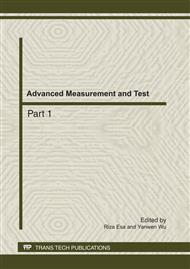p.881
p.885
p.890
p.895
p.902
p.908
p.913
p.919
p.924
Microwave Power Real-Time Soft-Measuring Based on Improved BP Neural Network
Abstract:
There are many faults in microwave power measurement in the working spots. In this paper, the novel technique of microwave power measurement and Schottky detector and the technique of soft-measuring based on improved BP neural network are presented. Making use of directional coupler, the part of power of microwave signal in transmission line was taken in the certain proportion. Then, the microwave power meter indicated the magnitude of power. The microwave power measurement system was composed of tuneable attenuator, directional coupler, matching load, peak-peak value detector, oscillograph, thermocouple, soft-measuring algorithm and so on. The low microwave power meter obtained the sample data of training BP neuron network. Then, the output of trained BP neural network may represent the result of high microwave power measurement. The experiments and applications in practice project prove that this new method has many advantages.
Info:
Periodical:
Pages:
902-907
Citation:
Online since:
July 2011
Authors:
Price:
Сopyright:
© 2011 Trans Tech Publications Ltd. All Rights Reserved
Share:
Citation:


